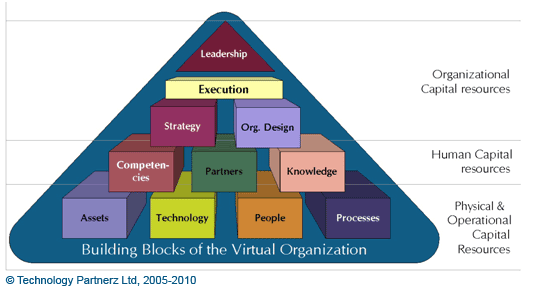Feb
02
2011
This article covers the competencies, resources and assets that must be developped when making the transition to virtual organizing
 A variety of authors have generated lists of firm capabilities and resources that may enable firms to conceive of and implement value-creating strategies (Barney, 1991; Bharadwaj, 2000).
A variety of authors have generated lists of firm capabilities and resources that may enable firms to conceive of and implement value-creating strategies (Barney, 1991; Bharadwaj, 2000).
In order to better define Venkatraman & Henderson's virtual organization, we have broken it down into components that are inspired by Barneys' (1991) three generic resource types and Nitin Nohria's (2003) model of organizational competencies; competencies that have characterized firms who performed exceptionally and developed or maintained a leadership position over the last 10 years. Nohria also suggests that to achieve overall success you need to excel in all 4 primary competencies and at least 2 of the secondary (See Figure 3). However Nohria emphasizes execution as primary means of success and differentiation.
For this reason, we have put it (execution) at the top of the model (see Figure 4) to illustrate the universal importance of this competency.
|
Primary Competencies
|
Secondary Competencies
|
- Strategy
- Culture
- Structure
- Execution
|
- Mergers and Partnerships
- Leadership
- Talent
- Innovation
|
Figure 3: Organizational Competencies - Nohria (2003)
Distinct from Nohria's (2003) approach in explaining company success, Barney suggests that numerous possible firm resources can be conveniently classified into three categories:
- Physical (& Operational) capital resources (Williamson, 1975, Venkatraman & Henderson, 1993) include the IS/IT processes, IS/IT Infrastructure, Operational and Adminstratives processes, physical technology used in a firm, a firm's plant and equipment, its geographic location, and its access to raw materials.
- Human capital resources (Becker, 1964) include the training, experience, judgment, intelligence, relationships, and insight of individual managers and workers in a firm.
- Organizational capital resources (Tomer, 1987) include a firm's formal reporting structure, its formal and informal planning, controlling, and coordinating systems, as well as informal relations among groups within a firm and between a firm and those in its environment.

Figure 4: A resource-based view of the virtual organization
In order to create value and develop a sustained competitive advantage, organizations require several things: Strategy, Resources (Human, Capital or other) and infrastructure. Therefore by developing a thorough understanding of the virtual organization in terms of resources, it then becomes much easier to mobilize and align them to business objectives.
In our next section, we are going to look at how organizations can deploy their resources in alignment with their virtual strategy.
SOURCES
- What really works, Nitin Nohria, William Joyce, and Bruce Robertson, Harvard Business Review – July 2003
- Firm Resources and Sustained Competitive Advantage, Jay Barney, Journal of Mangagement, Vol. 17, No. 1, 1991
- Markets and hierarchies, O. Williamson, New York Free Press, 1975
- Human capital, G.S. Becker, New York, Columbia 1964
- Organizational Capital: The path to higher productivity and well-being, J.F. Tomer, Preager 1987